Turn your FunnelKit Sign-Ups and Reviews into Social Proof
FunnelKit previously known as WooFunnels, is a comprehensive sales funnel builder specifically designed for WooCommerce, the popular e-commerce plugin for WordPress. It helps businesses create high-converting sales funnels, optimize checkout processes, and enhance customer engagement.
You can easily connect FunnelKit to Nudgify with our FunnelKit integration to showcase Social Proof notifications on your website, in real-time.
Connect Reviews and/or Sign-ups
You can connect two types of FunnelKit’s data to Nudgify: reviews and sign-ups. You can use our FunnelKit Sign-up Integration to connect new users that are added in your FunnelKit account and show them in Sign-up Nudges. You can use our FunnelKit Reviews Integration to connect your and our FunnelKit reviews, and show them in Review Nudges.
Connect FunnelKit Sign-ups
The following data from FunnelKit will be synced with Nudgify in order to build Nudges:
- Full Name
- City
- State
- Country
- Date
Follow the steps below to connect your FunnelKit user data to Nudgify and show new contacts in Sign-up Nudges.
Step 1. Copy Your Webhook URL
To manage your integrations, click the “Integrations” button on the left-hand sidebar. This will take you to the Integrations page, where you manage your integrations with other apps and software. Find FunnelKit Sign-Ups in the list and click “Connect”.

Click to copy your Nudgify Webhook URL
Step 2. Create a Webhook in FunnelKit and paste your Webhook URL
You will now paste your Nudgify Webhook URL in the right place in your FunnelKit account so that new user data is sent automatically to your Nudgify account.
As a summary, follow these steps in your FunnelKit dashboard:
- Go to Automations
- Create a new automation, select start from scratch.
- Give your automation a name and proceed.
- For the trigger/event, chose User Created under WordPress.
- Add a new action, select Send Data To Any Source action under Send Data.
- Copy the Nudgify Webhook URL from your Nudgify account.
- Paste your Nudgify Webhook URL in the URL field.
- Under Method, select Post.
- Under Data, set your data fields according to the steps below.
- For First Name property name to “first_name” and the property value as {{contact_first_name}}.
- For Last Name property name to “last_name” and the property value as {{contact_last_name}}.
- For Email property name to “email” and the property value as {{contact_email}}.
- For City property name to “city” and the property value as {{contact_city}}.
- For State property name to “state” and the property value as {{contact_state}}.
- For Country property name to “country” and the property value as {{contact_country format=’full’}}.
- For Date property name to “date” and the property value as {{contact_creation_date}}
- Save the step.
- Activate your flow, and you are ready to go.

Any new Sign-up will be added to your Sign-ups Data Feed. To turn these data into Social Proof Nudges on your site, create a Sign-up Nudge and select FunnelKit as the data source.
Congratulations! You have now linked your new FunnelKit sign-ups to Nudgify 🙌
Step 3. Create Sign-ups Nudges for new FunnelKit Users
On your Data Feeds page, in the “sign-ups” tab, you will be able to see any new contacts that are sent to Nudgify. It’s time to start showcasing new FunnelKit sign-ups in Social Proof Nudges!
You can create two types of Nudges with the FunnelKit sign-ups integration.
- Recent Sign-Ups Nudges that show single sign-ups
- All Sign-Ups Nudges that show a count of multiple sign-ups
Show Recent Activity – Single Sign-ups
Go to the Nudges page and click “Add Nudge”. Choose the Nudge labeled “Recent Activity – Single Sign-up” from the Nudge Library.
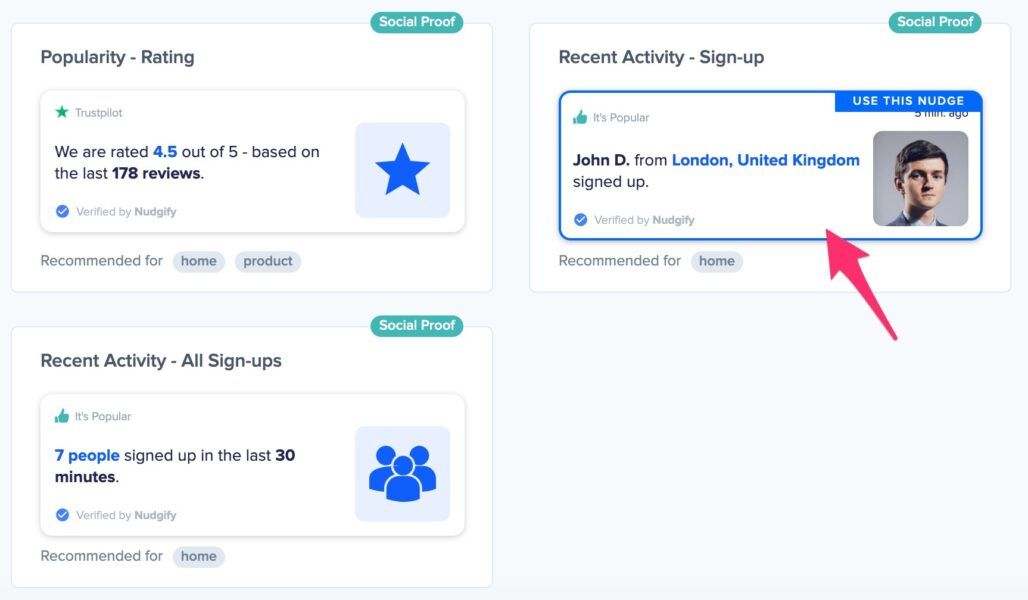
You can now configure the selected Nudge. First of all, select “FunnelKit Sign-Ups” as the data source. This way, the Nudge will use your FunnelKit data to show in the Nudge:
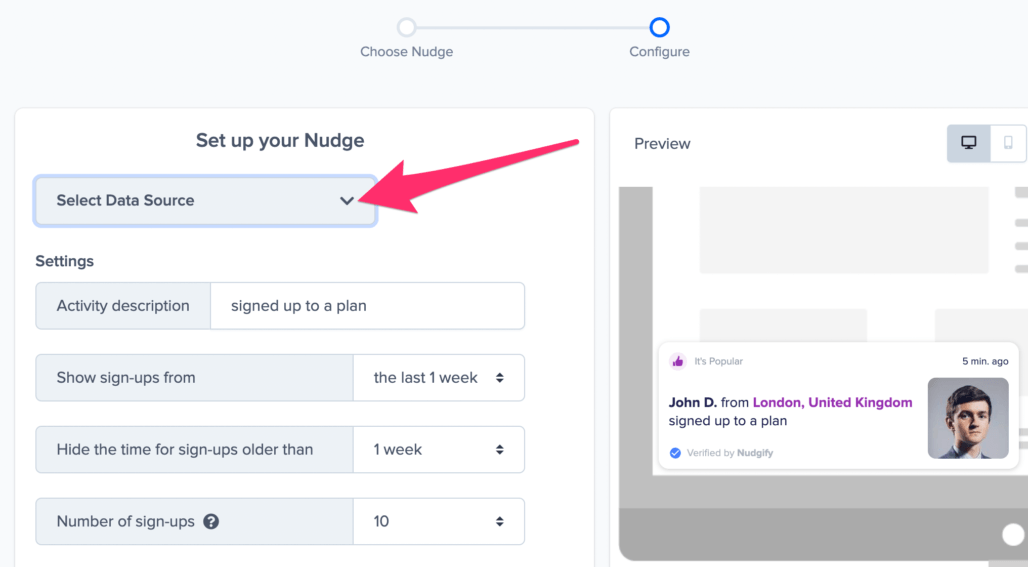
You can also customise the text of the Nudge here (“subscribed to our newsletter”, “signed-up to our mailing list”, or whatever you want to display). You can also select how recent the sign-ups need to be that you want to display. Find out more about the customisation options for Sign-up Nudges.
Once you’re done, click “Continue”. The Nudge will now automatically capture and show individual recent sign-ups. You can track how your Nudges perform from your Statistics page.
Show All Sign-ups
When creating a new Nudge, choose the “Recent Activity – All Sign-ups” Nudge in your Nudge Library:
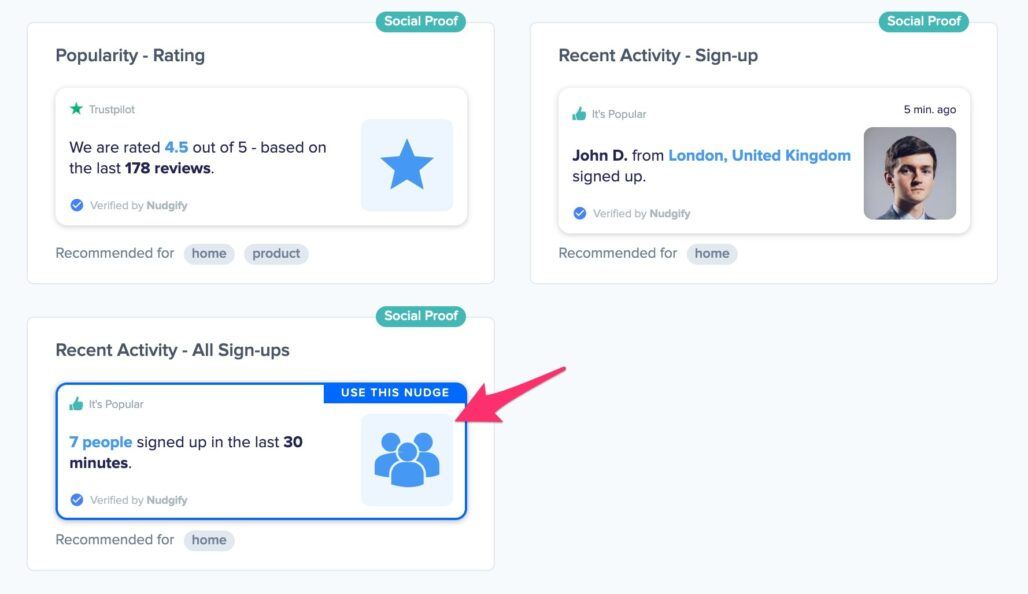
You can now configure the selected Nudge. First of all, select “FunnelKit Sign-Ups” as the data source. This way, the Nudge will use your FunnelKit data to show in the Nudge:
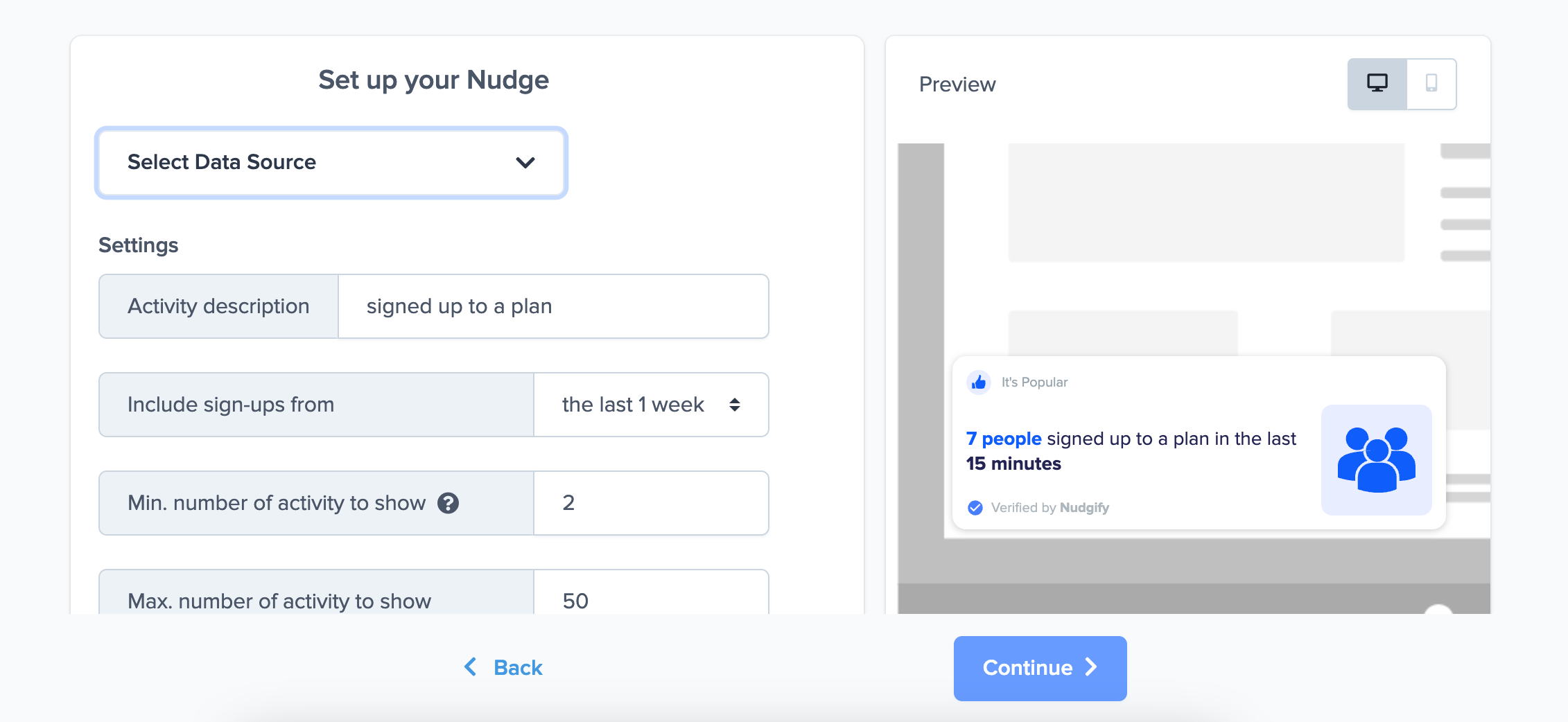
You can also customise the text of the Nudge here (“subscribed to our newsletter”, “signed-up to our mailing list”, or whatever else you want to put down). You can also select how recent the sign-ups need to be that you want to display, and set a minimum and maximum number of Sign-ups. Find more about the customization options for Sign-up Nudges.
Click “Continue”. The Nudge will now automatically capture and show a summary of recent subscriptions. You can track how your Nudges perform from your Statistics page.
That’s it! 🙌
All your new FunnelKit Sign-Ups will now be turned into powerful Social Proof automatically and display Nudges on your site.
Connect FunnelKit Reviews
The following data from FunnelKit will be synced with Nudgify in order to build Nudges:
- Full Name
- Date
- Product
- Rating
- Review text
Follow the steps below to connect your FunnelKit user data to Nudgify and show new reviews in Review Nudges.
Step 1. Copy Your Webhook URL
To manage your integrations, click the “Integrations” button on the left-hand sidebar. This will take you to the Integrations page, where you manage your integrations with other apps and software. Find FunnelKit in the list and click “Connect”.

Click to copy your Nudgify Webhook URL
Step 2. Create a Webhook in FunnelKit and paste your Webhook URL
You will now paste your Nudgify Webhook URL in the right place in your FunnelKit account so that new user data is sent automatically to your Nudgify account.
As a summary, follow these steps in your FunnelKit dashboard:
- Go to Automations
- Create a new automation, select start from scratch.
- Give your automation a name and proceed.
- For the trigger/event, chose User Created under WordPress.
- Add a new action, select Send Data To Any Source action under Send Data.
- Copy the Nudgify Webhook URL from your Nudgify account.
- Paste your Nudgify Webhook URL in the URL field.
- Under Method, select Post.
- Under Data, set your data fields according to the steps below.
- For Full Name property name to “full_name” and the property value as {{contact_full_name}}.
- For Review Rating property name to “review_rating” and the property value as {{review_rating}}.
- For Review Comment property name to “review_content” and the property value as {{review_content}}.
- For Product property name to “product_title” and the property value as {{product_title}}.
- For Date property name to “date” and the property value as {{current_datetime format=’d/m/Y’}}
- Save the step.
- Activate your flow, and you are ready to go.
Go back to Nudgify and click the “I’ve done it” button.

Any new Reviews will be added to your Reviews Data Feed. To turn these data into Social Proof Nudges on your site, create a Reviews Nudge and select FunnelKit as the data source.
Congratulations! You have now linked your new FunnelKit Reviews to Nudgify 🙌
Step 3. Create Reviews Nudges for new FunnelKit Users
On your Data Feeds page, in the “Reviews” tab, you will be able to see any new contacts that are sent to Nudgify. It’s time to start showcasing new FunnelKit Reviews in Social Proof Nudges!
You can create two types of Nudges with the FunnelKit Reviews integration.
- Recent Reviews Nudges that show single Reviews
- All Reviews Nudges that show a count of multiple Reviews
Show Recent Activity – Single Reviews
Go to the Nudges page and click “Add Nudge”. Choose the Nudge labeled “Recent Activity – Single Reviews” from the Nudge Library.

You can now configure the selected Nudge. First of all, select “FunnelKit Reviews” as the data source. This way, the Nudge will use your FunnelKit data to show in the Nudge:

You can also customize the text of the Nudge here (“subscribed to our newsletter”, “signed-up to our mailing list”, or whatever you want to display). You can also select how recent the Reviews need to be that you want to display. Find out more about the customisation options for Reviews Nudges.
Once you’re done, click “Continue”. The Nudge will now automatically capture and show individual recent Reviews. You can track how your Nudges perform from your Statistics page.
Show All Reviews
When creating a new Nudge, choose the “Recent Activity – All Reviews” Nudge in your Nudge Library:
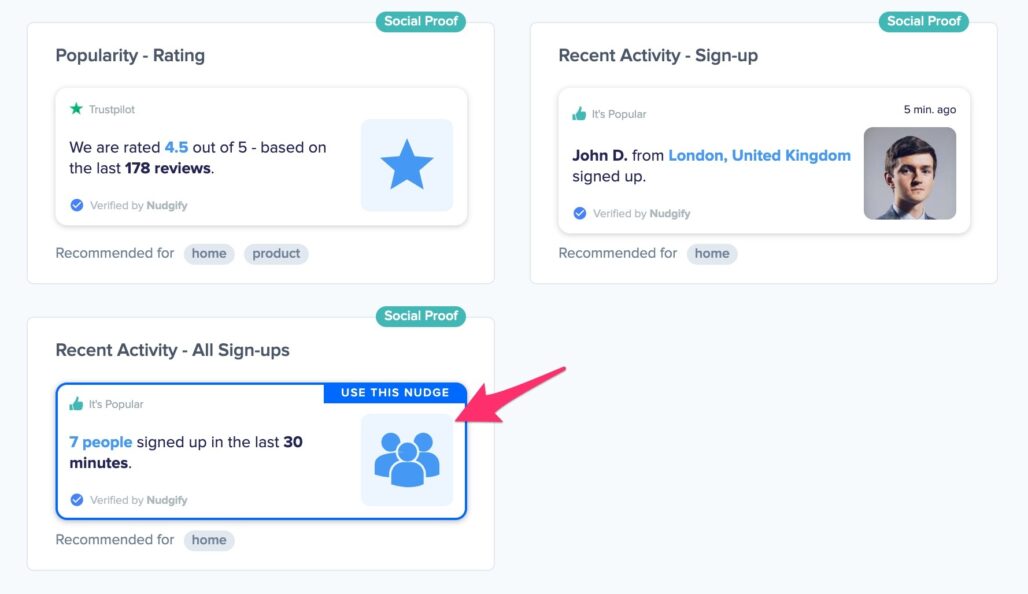
You can now configure the selected Nudge. First of all, select “FunnelKit Reviews” as the data source. This way, the Nudge will use your FunnelKit data to show in the Nudge:

You can also customise the text of the Nudge here (“subscribed to our newsletter”, “signed-up to our mailing list”, or whatever else you want to put down). You can also select how recent the Reviews need to be that you want to display, and set a minimum and maximum number of Reviews. Find more about the customization options for Reviews Nudges.
Click “Continue”. The Nudge will now automatically capture and show a summary of recent subscriptions. You can track how your Nudges perform from your Statistics page.
That’s it! 🙌
All your new FunnelKit Reviews will now be turned into powerful Social Proof automatically and display Nudges on your site.
